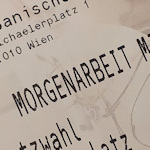
Morning training at the Spanish Riding School offers a chance to see the wonderful Lipizzaners in action without the cost of a full-blown performance. Though you still need to buy a ticket.
- One-hour session with introductory commentary
- The Lipizzaner stallions and their riders leave a remarkable impression (and I speak as a horse agnostic)
- Training occurs most weekday mornings
- …summer break in July
- Book tickets online* for a public training
- See also:
Training: a review
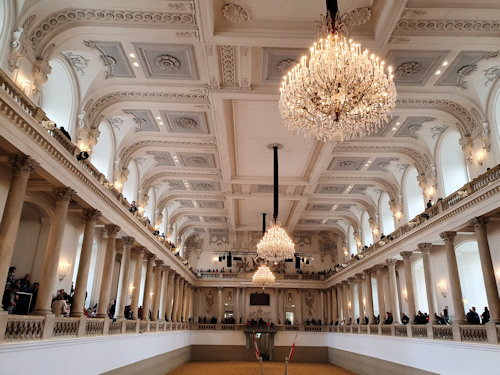
(The Baroque riding school winter arena where both gala performances and training sessions take place; photo taken with the kind permission of the SRS during a press tour)
Horses and I enjoy a mutual non-aggression pact. I keep clear of them and they keep clear of me.
So you might think me the last person to want to spend an hour watching Lipizzaners prance around the winter riding school for their morning training (Morgenarbeit in German).
I went in thinking the same, but came out genuinely moved by the whole experience.
Even the uninformed observer can see these horses possess a special presence, an almost other-worldly nobility, and the kind of poise and bearing you get from supreme athletes at the peak of their career.
The stallions bring a new meaning to the term, horsepower.
Combine the above with uniformed riders, some light classical music, an 18th-century riding school arena, and a centuries’ old tradition of horsemanship and you have something bordering on the mystical.
And this is just training.
So what do you see?
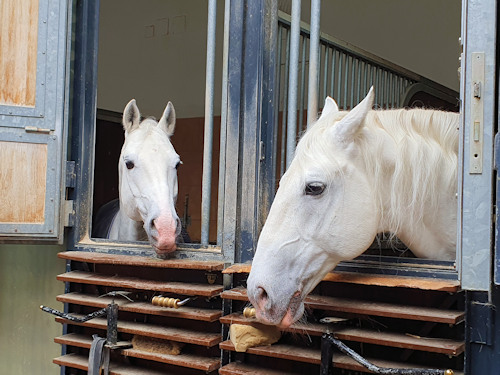
(Say hello to my new best friends; photo again taken with kind permission of the SRS during a press tour)
The schedule depends on current needs, but is normally split into two sessions (each with different horses).
This is what I experienced during separate visits to a public training…
The stallions warmed up, they trained, and they warmed down…with commentary at the start and finish. Which might sound a little meh (neigh?). Not so: I found it all fascinating.
One obvious joy is experiencing the skills of the horses first hand and at close quarters; both experienced stallions and the upcoming generation of four-legged stars attend the trainings.
The old pros, for example, glided through complicated steps like they were second nature (which I’m guessing they were).
Another joy is seeing the training process unfold before you: the focus & concentration, the interactions between rider and horse, etc.
We were lucky enough to witness stallions training the courbette and capriole jumps. Their successes drew genuine “oohs” of admiration from onlookers, their incomplete attempts genuine “ahhs” of sympathy.
Tip: Pay attention if you spot a horse begin to move diagonally across the arena: this is when a jump or other complicated move is more likely.
We also got to see a very rare dark stallion on one of the trips; they make up only 1% of the Lipizzaner population.
The training programme also gave us a clear feel for the rider-Lipizzaner bond, which appears almost telepathic at times.
(What you don’t see, of course, is the kind of coordinated multiple-horse moves you get at the galas and performances.)
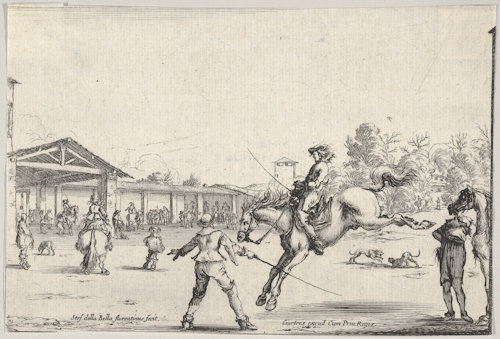
(A riding school from around 1645. Image courtesy of the Metropolitan Museum of Art)
The two visits produced lots of little delightful moments. For example:
- A rider in brown tails and bicorne hat slipping their horse a little tidbit after some successful move (apparently the tailcoats have a special pocket sewn into them for storing the treats)
- The senior riders doffing their hat on entering the arena, a tradition upheld even when nobody is watching
- Training on the long rein with no rider, with the horse still observing perfect discipline
- Assistants appearing immediately to clear away when a horse lost a bit of excess weight out its back end (I’m trying to be polite)
- The dismount, when the horses line up and get a warm rug put over them before a groom escorts them back to their stables
Call me sentimental, but the music starting up gave me a shiver of emotion, too.
All-in-all, the visit left me with a stronger appreciation for the riding tradition, the work of the Spanish Riding School, and the prowess of the Lipizzaner stallions.
Perhaps me and horses might reach a better understanding, after all.
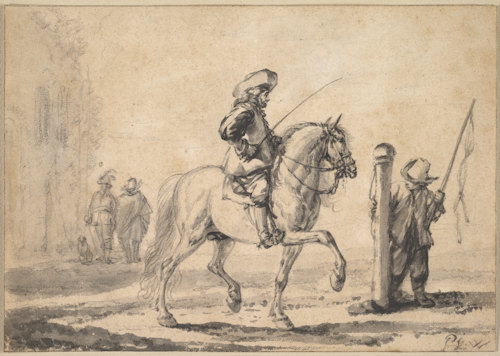
(A Mounted Grey Horse Being Schooled in Piaffe. Image courtesy of the Metropolitan Museum of Art)
Ticket & visitor tips
Consider a combination stable tour and training ticket package* for a full behind-the-scenes experience that saves a bit of money too. (Here’s my review of the stable tour.)
- Morning training typically takes place for one hour on four to five weekdays from 10am, with another slot at 11.30am on occasion (depends on the day and season). Weekend trainings are rare.
- Given the high demand and mixed schedule through the year, booking a date and ticket in advance* makes sense.
(Even in February, when Vienna turns relatively quiet, quite a queue for tickets built up at the counter as we approached the starting time.)
- The horses get a break for 4-6 weeks in summer (usually July) but the tours continue more or less all year
- Don’t expect every training unit to feature the more spectacular moves, since it depends on each horse’s training requirements on the day; younger stallions also need time to develop the required skills.
- Since the training is relatively informal, you can leave earlier without fear of appearing rude. Note that kids under 3 cannot go in.
- Visitors sit or stand above a sunken oval (a legacy of the historical building), so not every part of the training ground is visible from everywhere. For example, you might not see a horse when it passes immediately below you down a side.
How to get to the Spanish Riding School
See the bottom of the ticket tips article for travel advice for reaching the riding school, which is inside the very central Hofburg palace complex.
Address: Michaelerplatz 1, 1010 Vienna